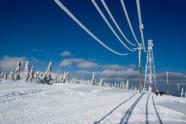Another winter of discontent

Who can forget the dreaded Polar Vortex of ’14?
Energy retailers were caught in a vice-like grip of
spiking demand, diminished supply and a rapidly
degrading operational capability which crushed business
plans and even caused a few to shut their doors.
Those who hadn’t locked-in their gas or power rates
prior to last January’s sudden temperature drop learned
unhappy lessons about price-risk management, not
preparing for Black Swans, and the impact of energy
market volatility on the bottom line.
With much of the country currently under snow and PJM
Interconnection posting a new record Winter peak use in
mid-February, the time seems right to revisit the
lessons of the first Polar Vortex.
Lesson number one: extreme and unexpected weather events
are the new normal.
A crisis is born
First and foremost people did exactly as expected when
the temperatures began to plummet last year, they turned
up their thermostats en masse, putting huge strain on
the grid. Then generation capacity began to shrink as
coal-fired power plants and diesel generators froze up.
Pipeline constraints for natural gas also caused
problems.
The wholesale energy market responded accordingly: PJM’s
average on-peak power price jumped from $50 to $278, and
Henry Hub spot prices spiked from $3.95 to $8.15 MMBtu.
At the depths of deep freeze, South Carolina utility
SCE&G implemented rolling 15-minute blackouts to manage
demand. Many others were openly asking end customers to
turn down thermostats or even leave the curtains on
South-facing windows open so sunlight could heat their
homes. Most grid operators in the affected states were
compelled to draw on expensive demand response resources
from other suppliers, putting further upward pressure on
wholesale pricing.
In a different scenario, surging demand for electricity
might have meant increased revenue and profits for all.
But peak power isn't always the ideal scenario for
energy retailers. With too many customers on fixed-rate
contracts, demand and price volatility can obliterate
margins.

Lessons for 2015
Inadequate hedging against extreme variability in
wholesale pricing ultimately left many retailers
financially exposed, and scrambling to pay their bills.
When it announced its closure last year, Maryland
retailer Clean Currents said spot market prices during
the Polar Vortex had shot up by 500 percent. When PJM
issued its collateral call the company simply couldn’t
afford to pay. Virginia-based Dominion Resources
abruptly exited the retail electricity market while the
Polar Vortex was just beginning to subside, and
Illinois’ retailer FirstEnergy Solutions announced a
coming June surcharge of $5 to $15 for 220,000 of its
customers, to pay for spikes in wholesale power costs
during the deep freeze.
Meteorology has its limits
We’ve now had nearly a decade of news coverage
describing cold snaps, heat waves, extreme snowfall and
hurricanes as ‘once in a generation’ and
‘unprecedented’. If the first Polar Vortex caught you by
surprise, you were in good company. The Climate
Prediction Center (CPC) had actually forecast
higher-than-normal temperatures for much of the lower 48
from November to January 2014. In early November 2014
the National Weather Service was predicting ‘milder than
normal’ temperatures for the Northeast this winter. Tell
that to people in Buffalo.
In the retail energy sector, unexpected weather and a
dynamic book of customers means that the science behind
insuring supply can meet demand has to be nimble,
sophisticated and reliable. While grid operators and
large utilities tend to have robust energy trading and
risk management (ETRM) tools in place to mitigate the
impact of adverse weather, the winter of 2014 caught
many on the retail side. With disruptive weather events
becoming more frequent and intense, retail providers
need to take immediate steps to prepare for the next
one, and soon.
In energy markets however, information can be power -
literally. Better insight into past events can help
energy retailers be more proactive and build informed
strategies to mitigate the impact of Polar Vortex-level
price volatility.
Here are three recommendations for winter 2015 and
beyond:
- Aggregate trade and usage information on a single system. Historical data can then be turned quickly into load forecasts for expected monthly, long-term, short-term, hourly and even sub-hourly demand.
- Measure current usage against past weather parameters. For example, daily minimum and maximum temperatures.
- Apply forecasts and the impact of past parameters to individual trades. By allowing multiple meters to be assigned to a single retail power contract point, and including counterparty information associated with each meter, multiple meter-level demand forecasts can be aggregated to form the contract-level demand forecast for a trade.
Energy retailers will continue to face events that force
them to change their hedging strategy. In a market where
price hikes can bankrupt you or send customers fleeing
for their incumbent utilities, improving trading and
risk management capability has become mission critical.
The winter of 2014 and the current deep freeze across
much of the US provide ample lessons all of us. The
retail sector needs to continually prepare for ‘once in
a generation’ extreme weather conditions.
About the author

Mark A. Hill is a seasoned executive with over 20
years of experience in consulting, marketing, sales and
project management. In his role as Vice President of
Sales for North America for Allegro, he is responsible
for increasing revenue, building a sustainable sales
pipeline and maintaining the highest levels of customer
service through effective account management practices.
Mark previously served as Managing Consultant at
Springboard Consulting U.S., specializing in corporate
growth. He also held various leadership roles within the
energy and technology industries, including Vice
President of Information Systems & Business Practice
Management at Calpine Corporation, President at Trendec,
and Senior Vice President of Vertical Solutions at
Divine.
Copyright © 1996-2015 by CyberTech, Inc. All rights reserved.
To subscribe or visit go to: http://www.energycentral.com
To subscribe or visit go to: http://www.energybiz.com
http://www.energybiz.com/article/15/03/another-winter-discontent